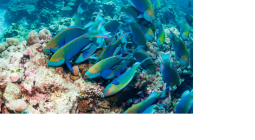Dr Lorenzo Álvarez-Filip, a coral scientist at the National Autonomous University of Mexico, has been surveying reefs across the Mexican Caribbean and the Gulf of Mexico after the bleaching in 2023 and again in 2024.
He said the most devastating impact was the loss of reef-building corals, such as elkhorns, that help protect coastlines and support a multitude of other marine life.
“Many of the coral colonies I knew well, and which had survived [a major disease] outbreak just a few years earlier, died in a matter of weeks.
“The feeling of impotence combined with the need to at least document what was happening made me very anxious – this was particularly hard when we were about to dive in sites where we knew there were big aggregations of susceptible corals. In almost all cases, we ended up with a very depressing feeling when we confirmed that all or nearly all the coral had died.”
Dr Valeria Pizarro, a senior coral scientist at the Perry Institute for Marine Science that works on reefs in the Bahamas and Caribbean, witnessed extreme bleaching in the Bahamas in July 2023.
She said “in a blink of my eyes” shallow reefs became white landscapes, with widespread death among staghorn corals used in restoration projects. Spectacular sea fans and soft corals died quickly.
“It was like they were melting with the heat,” she said.
“World leaders need to really commit to reduce fossil fuels and increase investments in clean energies and make it a reality. We need them to stop having it on paper and on the news, we need it to be real.”



